Data-Driven Distributed Model-Free Adaptive Predictive Control for Multiple High-Speed Trains Under False Data Injection Attacks
Abstract
1. Introduction
2. Preliminaries and Problem Description
2.1. Preliminaries
2.2. Dynamic Model of MHSTs
2.3. False Data Injection Attacks
2.4. Controller Design
2.5. Parameter Estimation Algorithm
2.6. PPD Prediction Algorithm
| Algorithm 1 Distributed Model-Free Adaptive Predictive Control Algorithm |
|
3. Stability Analysis
4. Numerical Simulation
5. Conclusions
Author Contributions
Funding
Data Availability Statement
Conflicts of Interest
Correction Statement
References
- Liu, E.; Yang, H.; Cai, G. Optimization for the following operation of a high-speed train under the moving block system. IEEE Trans. Intell. Transp. Syst. 2017, 19, 3406–3413. [Google Scholar]
- Dong, H.; Ning, B.; Cai, B.; Hou, Z. Automatic train control system development and simulation for high-speed railways. IEEE Circuits Syst. Mag. 2010, 10, 6–18. [Google Scholar] [CrossRef]
- Zhao, Y.; Sun, H.; Yang, J.; Hou, L.; Yang, D. Event-Triggered Fully Distributed Bipartite Containment Control for Multi-Agent Systems Under DoS Attacks and External Disturbances. IEEE Trans. Circuits Syst. I Regul. Pap. 2025, 1–14. [Google Scholar] [CrossRef]
- Wang, Y.; Zhu, F. Distributed Hybrid Dynamic Event-Triggered Consensus Control for Nonlinear Multi-Agent Systems. IEEE Trans. Autom. Sci. Eng. 2025, 22, 10470–10483. [Google Scholar] [CrossRef]
- Wang, X.; Zhu, L.; Wang, H.; Tang, T.; Li, K. Robust distributed cruise control of multiple high-speed trains based on disturbance observer. IEEE Trans. Intell. Transp. Syst. 2019, 22, 267–279. [Google Scholar] [CrossRef]
- Tian, Y.; Lin, P. Cooperative control for multiple high-speed trains with constraints and acceleration zone under moving block system. Int. J. Robust Nonlinear Control 2022, 32, 3662–3673. [Google Scholar] [CrossRef]
- Wang, D.; Su, S.; Han, L.; Li, D. Finite-time distributed adaptive coordinated control for multiple traction units of high-speed trains. IEEE Trans. Intell. Transp. Syst. 2024, 25, 8499–8513. [Google Scholar] [CrossRef]
- Guo, Y.; Wang, Q.; Sun, P.; Feng, X. Distributed adaptive fault-tolerant control for high-speed trains using multi-agent system model. IEEE Trans. Veh. Technol. 2023, 73, 3277–3286. [Google Scholar] [CrossRef]
- Guo, Y.; Sun, P.; Wang, Q.; Feng, X. Adaptive cooperative control for multiple high-speed trains with uncertainties, input saturations and state constraints. Control Eng. Pract. 2024, 142, 105768. [Google Scholar] [CrossRef]
- Gao, S.; Song, Q.; Shen, D. Distributed learning control for high-speed trains subject to operation safety constraints. IEEE Trans. Cybern. 2023, 54, 1794–1805. [Google Scholar] [CrossRef]
- Zhu, L.; Li, X.; Huang, D.; Dong, H.; Cai, L. Distributed cooperative fault-tolerant control of high-speed trains with input saturation and actuator faults. IIEEE Trans. Intell. Veh. 2022, 8, 1241–1251. [Google Scholar] [CrossRef]
- Hou, Z.; Chi, R.; Gao, H. An overview of dynamic-linearization-based data-driven control and applications. IEEE Trans. Ind. Electron. 2016, 64, 4076–4090. [Google Scholar] [CrossRef]
- Bu, X.; Hou, Z.; Yu, Q.; Yang, Y. Quantized Data Driven Iterative Learning Control for a Class of Nonlinear Systems with Sensor Saturation. IEEE Trans. Syst. Man Cybern. Syst. 2020, 50, 5119–5129. [Google Scholar] [CrossRef]
- Zhao, H.; Zhang, Q.; Peng, L.; Yu, H. Resource-efficient model-free adaptive platooning control for vehicles with encrypted information. IEEE Trans. Intell. Transp. Syst. 2024, 25, 20006–20016. [Google Scholar] [CrossRef]
- Yu, W.; Wang, R.; Bu, X.; Hou, Z.; Wu, Z. Resilient Model-Free Adaptive Iterative Learning Control for Nonlinear Systems Under Periodic DoS Attacks via a Fading Channel. IEEE Trans. Syst. Man Cybern. Syst. 2022, 52, 4117–4128. [Google Scholar] [CrossRef]
- Bu, X.; Liang, J.; Hou, Z.; Chi, R. Data-driven terminal iterative learning consensus for nonlinear multiagent systems with output saturation. IEEE Trans. Neural Networks Learn. Syst. 2020, 32, 1963–1973. [Google Scholar] [CrossRef]
- Yang, Z.; Hou, M.; Hou, Z.; Jin, S. Disturbance observer dynamic linearization-based model-free adaptive control for discrete-time nonlinear systems. IEEE Trans. Cybern. 2024, 54, 6957–6970. [Google Scholar] [CrossRef]
- Bu, X.; Yu, W.; Yu, Q.; Hou, Z.; Yang, J. Event-triggered model-free adaptive iterative learning control for a class of nonlinear systems over fading channels. IEEE Trans. Cybern. 2021, 52, 9597–9608. [Google Scholar] [CrossRef]
- Yu, W.; Huang, D.; Qin, N. Resilient coordinated data-driven control of multiple high-speed trains under fading measurements and denial-of-service attacks. IEEE Trans. Veh. Technol. 2023, 72, 5690–5701. [Google Scholar] [CrossRef]
- Wang, Q.; Jin, S.; Hou, Z. Data-driven event-triggered cooperative control for multiple subway trains with switching topologies. IEEE Trans. Intell. Transp. Syst. 2021, 23, 14702–14711. [Google Scholar] [CrossRef]
- Mayne, D.Q. Model predictive control: Recent developments and future promise. Automatica 2014, 50, 2967–2986. [Google Scholar] [CrossRef]
- Li, H.; Wang, C.; Yuan, S.; Zhu, H.; Li, B.; Liu, Y.; Sun, L. Energy Scheduling of Hydrogen Hybrid UAV Based on Model Predictive Control and Deep Deterministic Policy Gradient Algorithm. Algorithms 2025, 18, 80. [Google Scholar] [CrossRef]
- Jin, L.; Liu, L.; Wang, X.; Shang, M.; Wang, F.-Y. Physical-informed neural network for MPC-based trajectory tracking of vehicles with noise considered. IEEE Trans. Intell. Veh. 2024, 9, 4493–4503. [Google Scholar] [CrossRef]
- Pan, T.; Hou, J.; Jin, X.; Yu, Z.; Zhou, W.; Wang, Z. Distributed Control of Hydrogen-Based Microgrids for the Demand Side: A Multiagent Self-Triggered MPC-Based Strategy. Algorithms 2024, 17, 251. [Google Scholar] [CrossRef]
- Ates, C.; Bicat, D.; Yankov, R.; Arweiler, J.; Koch, R.; Bauer, H.-J. Model predictive evolutionary temperature control via neural-network-based digital twins. Algorithms 2023, 16, 387. [Google Scholar] [CrossRef]
- Li, B.; Guan, T.; Dai, L.; Duan, G.-R. Distributionally robust model predictive control with output feedback. IEEE Trans. Autom. Control 2023, 69, 3270–3277. [Google Scholar] [CrossRef]
- Xu, X.; Peng, J.; Zhang, R.; Chen, B.; Zhou, F.; Yang, Y.; Gao, K.; Huang, Z. Adaptive model predictive control for cruise control of high-speed trains with time-varying parameters. J. Adv. Transp. 2019, 2019, 7261726. [Google Scholar] [CrossRef]
- Hou, Z.; Jin, S. Data-driven model-free adaptive control for a class of MIMO nonlinear discrete-time systems. IEEE Trans. Neural Networks 2011, 22, 2173–2188. [Google Scholar]
- Li, F.; Hou, Z. Event-triggered model-free adaptive predictive control for networked control systems under deception attacks. IEEE Trans. Syst. Man Cybern. Syst. 2023, 54, 1325–1334. [Google Scholar] [CrossRef]
- Bu, X.; Dai, X. Event-triggered model-free adaptive predictive control for multi-area power systems under deception attacks. Energy Rep. 2023, 9, 1812–1825. [Google Scholar] [CrossRef]
- Wang, D.; Wang, F. Model-Free Adaptive Predictive Tracking Control for High-Speed Trains Considering Quantization Effects and Denial-of-Service Attacks. Actuators 2024, 13, 301. [Google Scholar] [CrossRef]
- Hou, Z.; Lei, T. Constrained model free adaptive predictive perimeter control and route guidance for multi-region urban traffic systems. IEEE Trans. Intell. Transp. Syst. 2020, 23, 912–924. [Google Scholar] [CrossRef]
- Xiong, H.; Chen, G.; Ren, H.; Li, H. Broad-Learning-System-Based Model-Free Adaptive Predictive Control for Nonlinear MASs Under DoS Attacks. IEEE/CAA J. Autom. Sin. 2025, 12, 381–393. [Google Scholar] [CrossRef]
- Pan, Z.; Hou, Z.; Chi, R. Distributed model-free adaptive predictive control for heterogeneous nonlinear multi-agent systems. Int. J. Syst. Sci. 2022, 53, 3027–3041. [Google Scholar] [CrossRef]
- Pan, Z.; Chi, R.; Hou, Z. Distributed model-free adaptive predictive control for MIMO multi-agent systems with deception attack. IEEE Trans. Signal Inf. Process. Netw. 2024, 10, 32–47. [Google Scholar] [CrossRef]
- Bu, X.; Dai, X.; Wu, J.; Ni, M. Resilient distributed model-free adaptive predictive control for multiarea power systems under denial of service attack. Asian J. Control 2023, 25, 4567–4580. [Google Scholar] [CrossRef]
- Zhao, H.; Dai, X.; Ding, L.; Cui, D.; Ding, J.; Chai, T. Resilient cooperative control for high-speed trains under denial-of-service attacks. IEEE Trans. Veh. Technol. 2021, 70, 12427–12436. [Google Scholar] [CrossRef]
- Xiao, S.; Ge, X.; Wu, Q. Attack-resilient distributed cooperative control of virtually coupled high-speed trains via topology reconfiguration. IEEE/CAA J. Autom. Sin. 2024, 11, 1066–1068. [Google Scholar] [CrossRef]
- Zhao, H.; Dai, X.W. Event-triggered adaptive control for multiple high-speed trains with deception attacks in bottleneck sections. Inf. Sci. 2021, 547, 470–481. [Google Scholar] [CrossRef]
- Yu, W.; Huang, D.; Wang, X.L.; Dong, H. Data-driven security consensus tracking of multiple high-speed trains under random topologies with data recovery mechanism. IEEE Trans. Control Syst. Technol. 2024, 32, 2298–2309. [Google Scholar] [CrossRef]
- Yu, W.; Huang, D.; Sun, P.; Wang, Q. Sliding mode control for high-speed train via event-triggered strategy under energy-limited deception attacks. IEEE Trans. Veh. Technol. 2023, 73, 1554–1566. [Google Scholar] [CrossRef]
- Yang, S.; Xu, J.; Li, X. Iterative learning control with input sharing for multi-agent consensus tracking. Syst. Control Lett. 2016, 94, 97–106. [Google Scholar] [CrossRef]
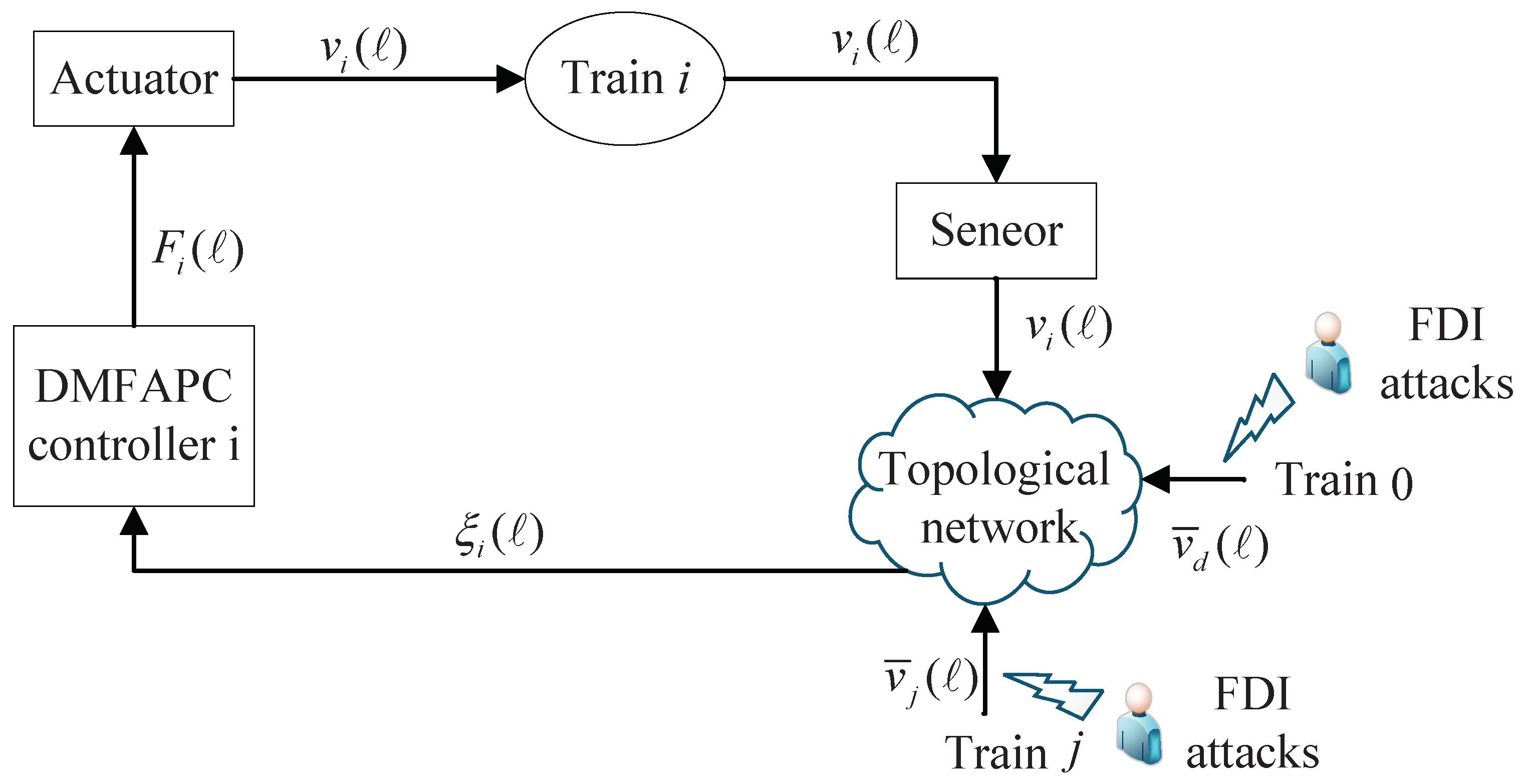

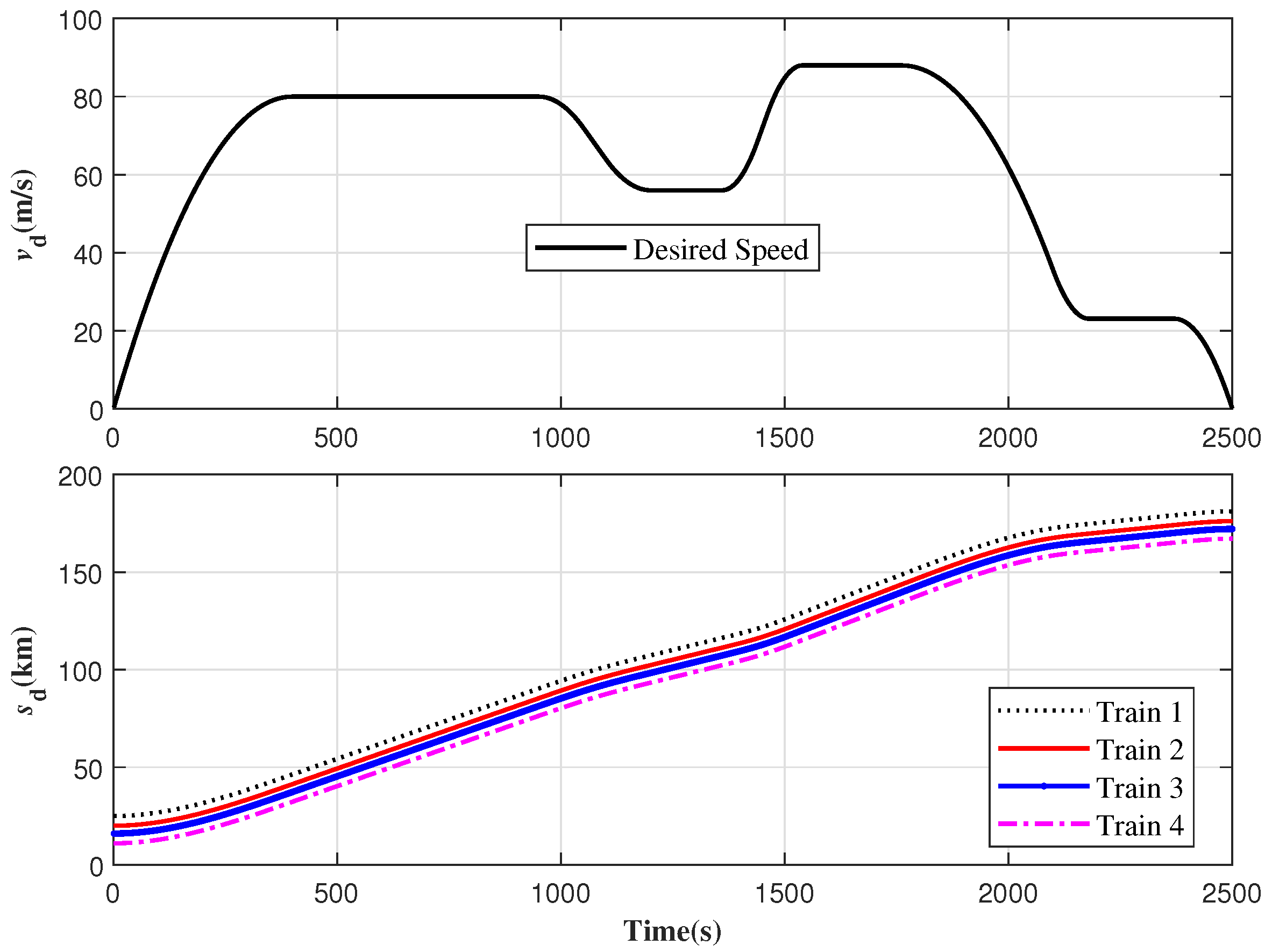
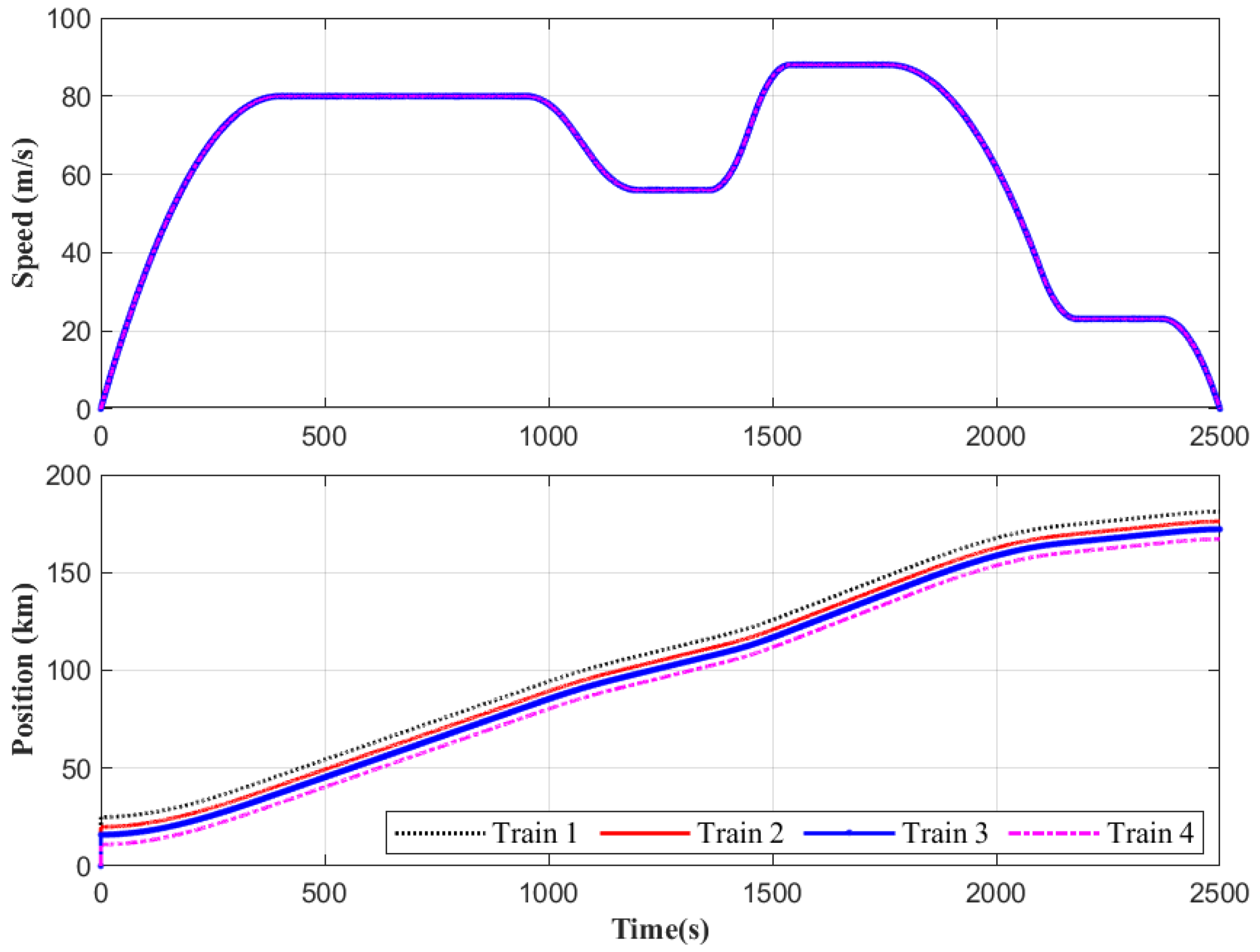
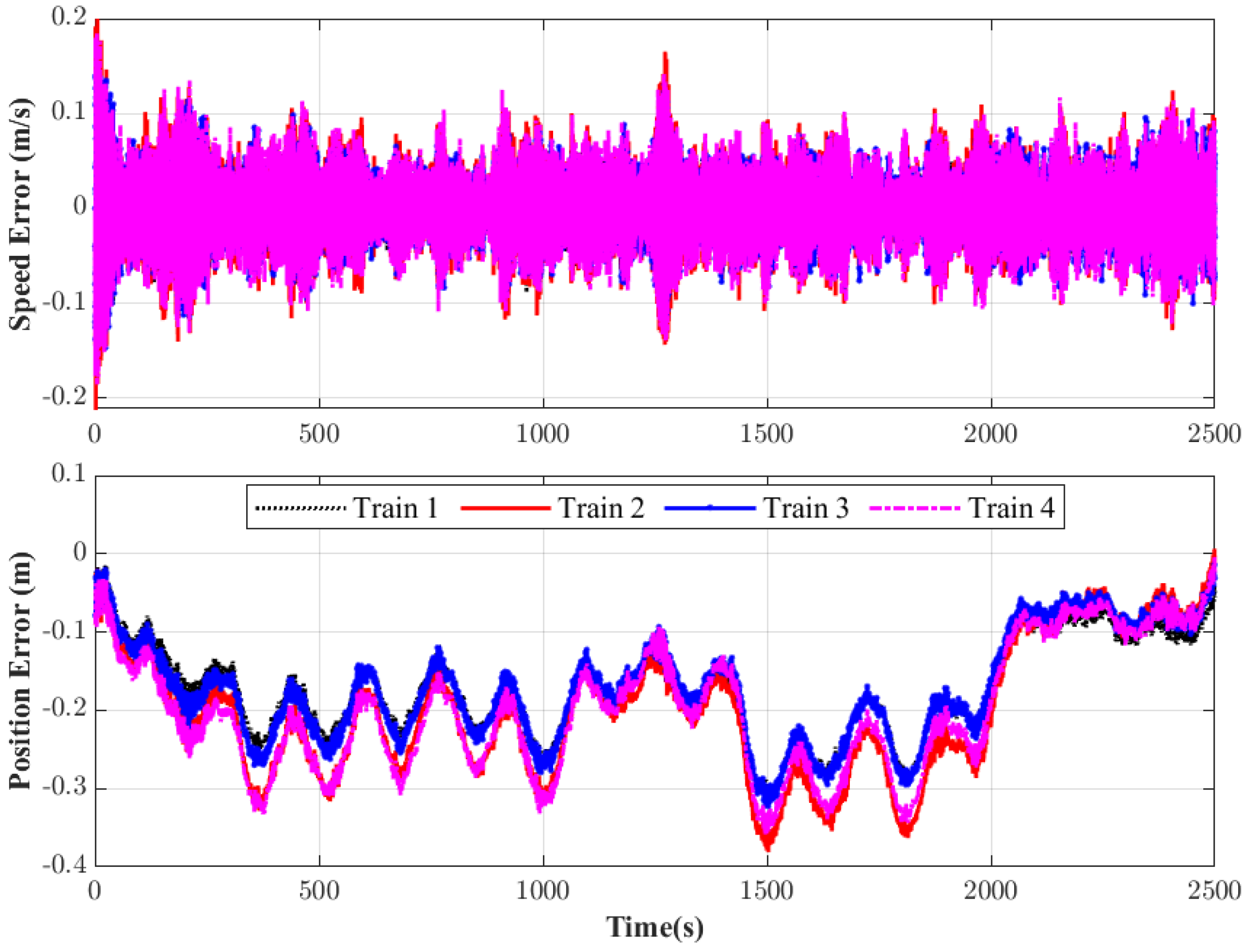
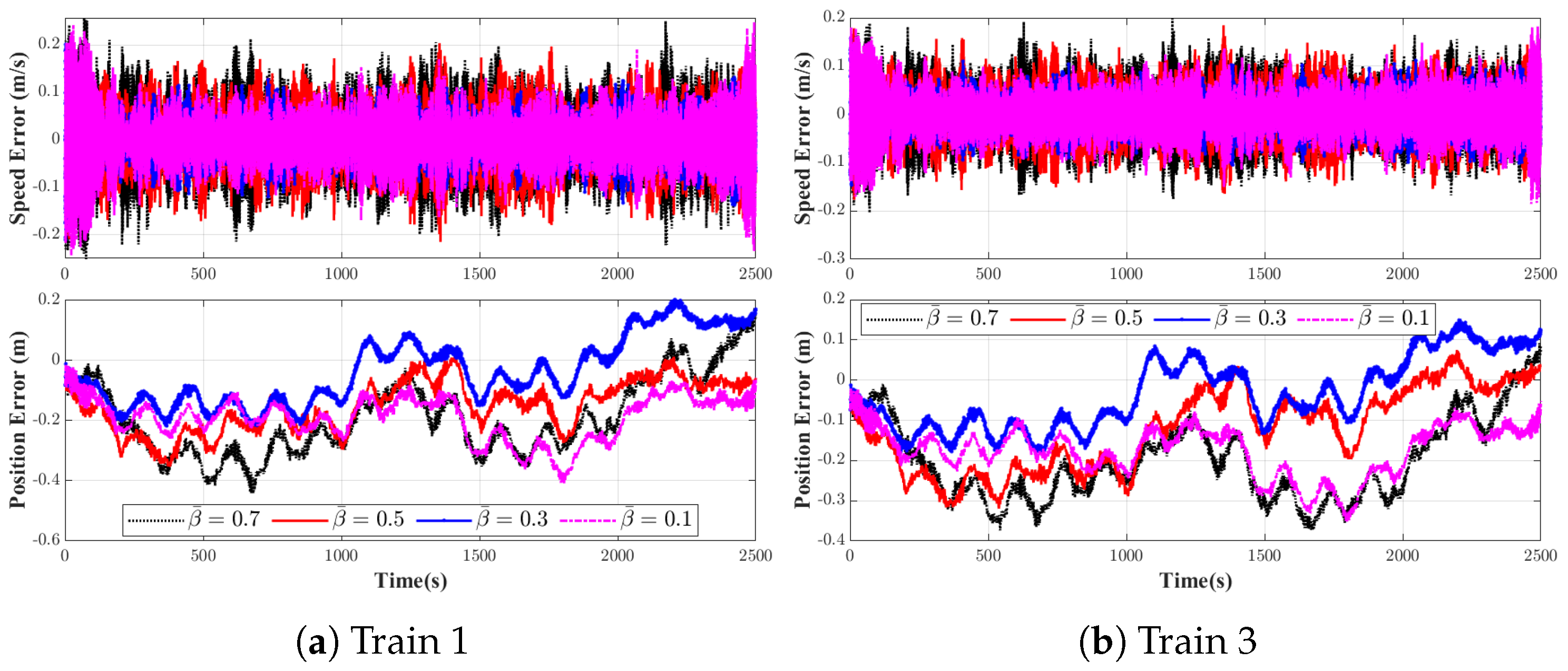
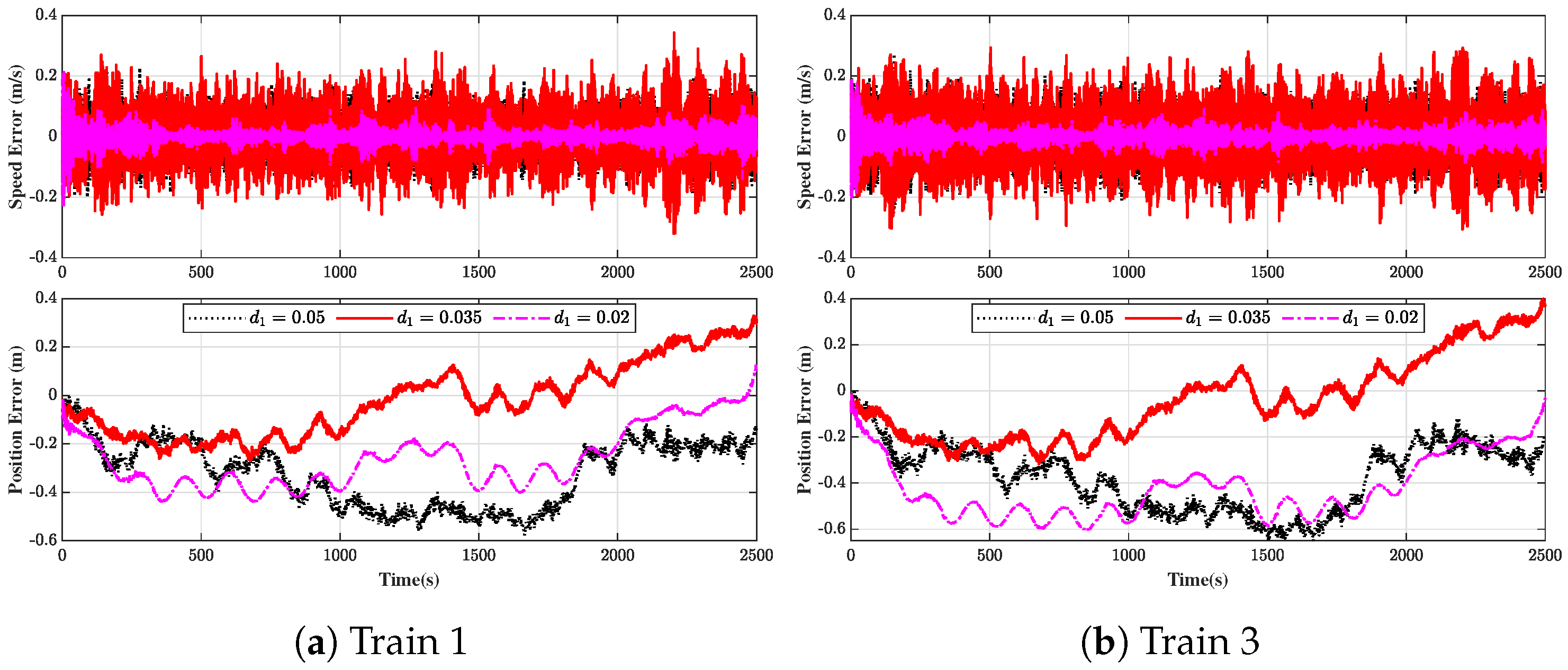
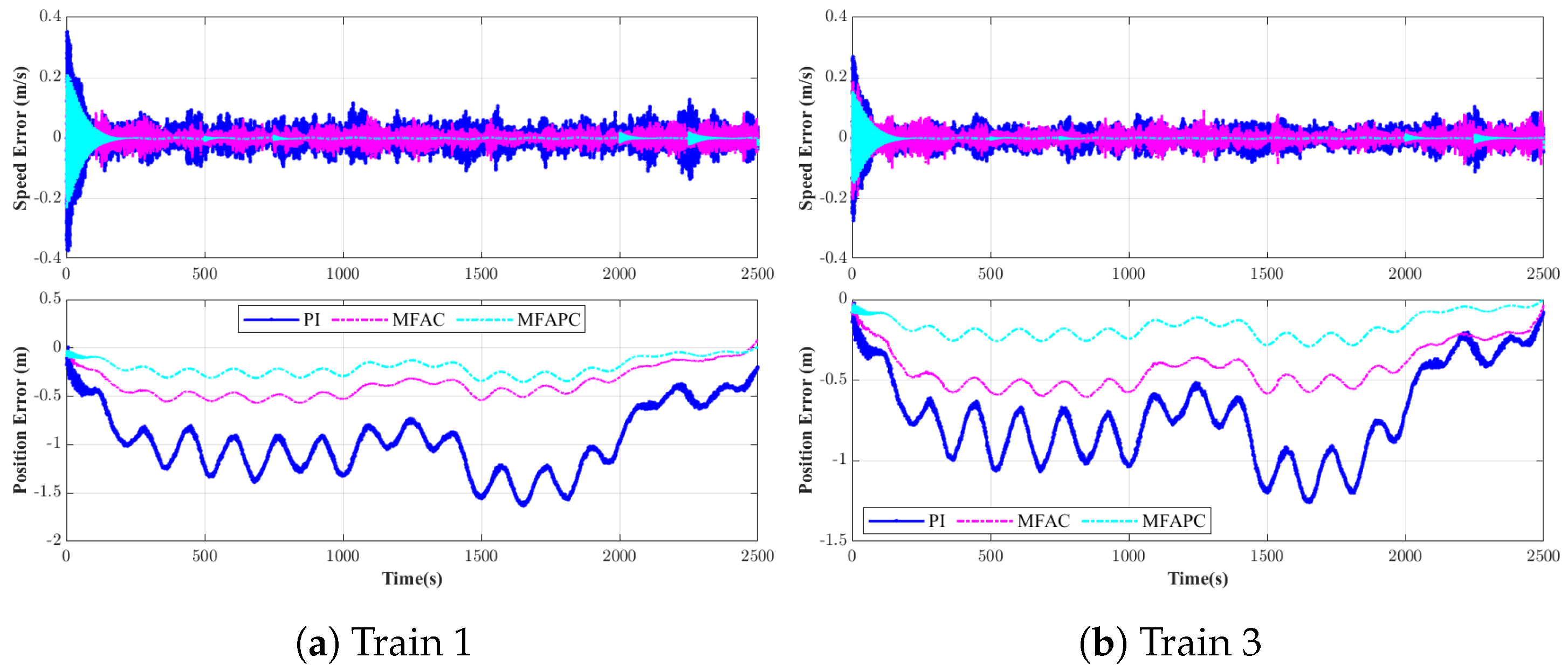
| Notation | Description |
|---|---|
| the train speed, | |
| the train position, | |
| the train traction/braking force, | |
| the supplementary resistance, | |
| ℓ | the sampling moment, |
| the N-step forward prediction vector of the system’s output, | |
| the control input increment, | |
| Inverse of a matrix , | |
| Transpose the matrix , |
Disclaimer/Publisher’s Note: The statements, opinions and data contained in all publications are solely those of the individual author(s) and contributor(s) and not of MDPI and/or the editor(s). MDPI and/or the editor(s) disclaim responsibility for any injury to people or property resulting from any ideas, methods, instructions or products referred to in the content. |
© 2025 by the authors. Licensee MDPI, Basel, Switzerland. This article is an open access article distributed under the terms and conditions of the Creative Commons Attribution (CC BY) license (https://creativecommons.org/licenses/by/4.0/).
Share and Cite
Zhang, B.; Wang, D.; Wang, F. Data-Driven Distributed Model-Free Adaptive Predictive Control for Multiple High-Speed Trains Under False Data Injection Attacks. Algorithms 2025, 18, 267. https://doi.org/10.3390/a18050267
Zhang B, Wang D, Wang F. Data-Driven Distributed Model-Free Adaptive Predictive Control for Multiple High-Speed Trains Under False Data Injection Attacks. Algorithms. 2025; 18(5):267. https://doi.org/10.3390/a18050267
Chicago/Turabian StyleZhang, Bin, Dan Wang, and Fuzhong Wang. 2025. "Data-Driven Distributed Model-Free Adaptive Predictive Control for Multiple High-Speed Trains Under False Data Injection Attacks" Algorithms 18, no. 5: 267. https://doi.org/10.3390/a18050267
APA StyleZhang, B., Wang, D., & Wang, F. (2025). Data-Driven Distributed Model-Free Adaptive Predictive Control for Multiple High-Speed Trains Under False Data Injection Attacks. Algorithms, 18(5), 267. https://doi.org/10.3390/a18050267




